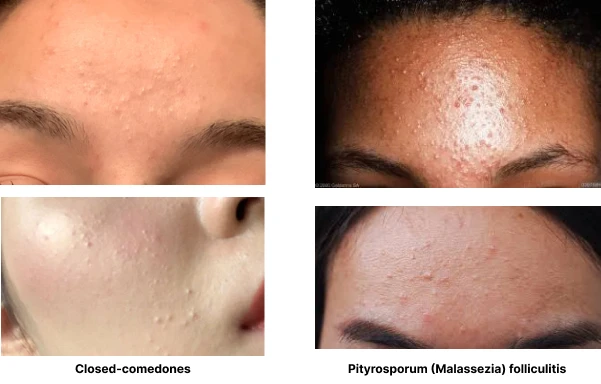Skincare already feels like a labyrinth. Fungal acne, in particular, is a pesky skin concern that can make the labyrinth seem more complex. Today, we're here to walk you through the labyrinth by answering the most important questions:
- What is fungal acne?
- How can I tell if I have fungal acne?
What is fungal acne?
You’ll hear the term “fungal acne” all the time, but it’s not an official diagnosis.
The medical term is Pityrosporum folliculitis, also known as Malassezia folliculitis.
The medical condition is actually called Pityrosporum (Malassezia) folliculitis.
The term 'fungal acne' is misleading:
- It is not actually acne; acne is caused by bacteria.
- It is not caused by fungus but rather a yeast that already lives on our skin.
This yeast is called Pityrosporum yeast. It falls into a family of yeast that cause skin conditions called Malassezia. Dandruff is also caused by a yeast in the Malassezia family.
Our skin has a natural microbiome of yeast, fungus, bacteria, and mites. A balanced microbiome plays a role in healthy skin:
- protects our skin from outside microorganisms
- reduces inflammation
- uphold the process of cell turnover
The natural yeast found in skin only becomes an issue when it grows out of control.
Signs of fungal acne
Dermatologists agree it is critical to distinguish between fungal acne and acne. The two are often confused which can lead to prolonged treatment (and wasted money).
Here are some key differences you should know:
- Fungal acne looks like uniform pink bump, also called papules. Each papule will look almost identical.
- It doesn’t include comedones; comedones are whiteheads, blackheads, inflammatory papules, pustules, and nodules.
- Studies show the majority of diagnosed patients feel itchy.
- Fungal acne is mostly concentrated on our foreheads, hairlines, and upper backs.
FYI: Closed-comedones are often confused for fungal acne. These like small skin-colored bumps and give your skin a rough and bumpy texture. We have an article on closed-comedones as well.
 (Sources: MDacne.com, Ai Beauty Clinic UK, Averr Aglow, Olivia Skin and Hair Clinic)
(Sources: MDacne.com, Ai Beauty Clinic UK, Averr Aglow, Olivia Skin and Hair Clinic)
Note: It is possible to have both acne and fungal acne at the same time.
Self-diagnosis
Self-diagnosing skin conditions is tricky. Fungal acne can look like acne, rosacea, or even an allergic reaction, but each needs different treatment.
To get a definitive answer, it's best to consult with a dermatologist or medical professional. They can take a closer look at your skin and perform a swab/scrape test to check for the presence of yeast under a microscope.
This kind of test helps ensure you get the right diagnosis and the proper treatment. Misdiagnosing yourself could lead to trying the wrong products, which might make things worse or delay real results.